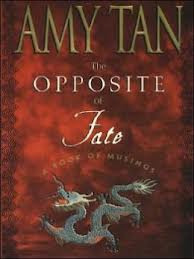Some years ago, by chance, I turned on the radio and heard Amy Tan on This American Life. She was talking about a time when she had been flat broke, and how a fender-bender had brought her the exact amount of money she needed to fix her cat’s broken leg. I always wanted to hear the whole story. Though I made a note to find that episode on the web, I never did. Then, during a library foray, I came upon The Opposite of Fate: A Book of Musings. Here was that long-sought story in its entirety, along with many others: Amy Tan’s travels to China, her recollections about Hollywood and writing the screenplay for The Joy Luck Club, conversational talks given at universities, her time with an all-author rock ‘n’ roll band.
The story that drew me to this book is the third one in, “A Question of Fate.” It is a dark tale about the murder of her friend Pete, and the ways in which her life and life path were changed by this horrific event that coincided with her 24th birthday. Pete, still grieving the death of his wife in a car accident, had a dream in which two men “…strangers to him, broke into his room, overcame him, and slowly strangled him to death…” Pete felt that the dream was a premonition. In fact, the dream did describe the circumstances and many details of his murder.
After his death, Amy Tan had a series of dreams in which Pete spoke to her. In one, he told her (accurately) the names of the two men who had murdered him. In another dream in which he invited her to go flying, Pete showed her that “…it’s your belief in yourself that enables you to do what you wish.”
There is a great ghost story, called “Room with a View, New Kitchen, and Ghosts.” “My Hair, My Face, My Nails” is a harrowing tale of a stay at a Tahoe cabin retreat, and how Amy Tan and her husband survived a monster flood that engulfed homes, trees, bridges and large chunks of earth along the Truckee River. She also writes a good deal about her mother — all those accounts made me grateful again for my own mother — I don’t think I could have survived Daisy Tan.
What I enjoyed most in this book is the author writing about writing itself, and the odd consequences of her success. “Required Reading and Other Dangerous Subjects” is a superb rant about the ways in which school can kill one’s love of literature. There are no educators, publishers, editors, or critics who are spared in this defense of those who write and read for themselves, for the pleasure they find in in stories and make-believe. “It disturbs me—” Amy Tan states, “—no, let me amend that—it terrifies me when I hear people dictating what literature must do and mean and say. And it infuriates me when people use the ‘authority’ of their race, gender, and class to stipulate who should write what, and why.”
Though this book goes in many directions, it is all held together by Amy Tan herself, an intelligent woman who writes well about her unique family history, her career, her love of language, and the mysterious, sometimes ridiculous things that comprise her life experience. For her, writing is “…a hope I will discover what I mean by truth…” She feels that reading, like writing, is an act of faith: “…if the writer and the reader discover the same thing, if they have that connection, the act of faith has resulted in an act of magic.”
I often felt that connection in reading these “musings.” Whether or not you find magic here, The Opposite of Fate is a good read.


Recent Comments